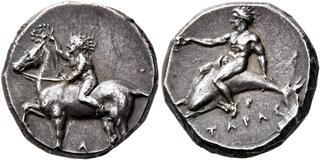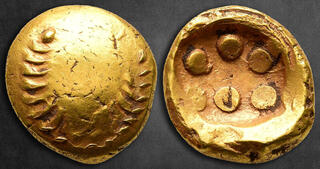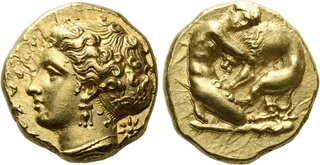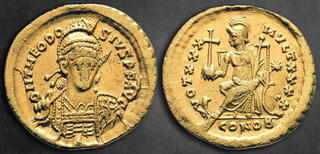Lot description:
Central Europe. Vindelici circa 100-1 BC. "Regenbogenschüsselchen" type
Stater AV
21 mm, 5,92 g
Triskeles, with a pellet within an annulet at the center and a pellet at the end of each leg, to right within a wreath-like torc with an annulet at each end / Pyramid of eight annulets: five, on the bottom, each enclosing a pellet, and three, forming the top two rows, each enclosing a smaller annulet; all within a wavy torc.
Near Mint State
Allen & Nash 160. Castelin 1097. De la Tour 9441. Dembski 467-9. Kellner type IX
The Regenbogenschüsselchen (Rainbow Cup) coins are a fascinating aspect of ancient numismatics, embodying the rich cultural and artistic heritage of the Vindelici, a Celtic tribe that inhabited the region of what is now Bavaria and Baden-Württemberg in Germany, and parts of Austria, during the late Iron Age. These coins are particularly notable for their distinctive designs and the symbolism they carry, which reflect the beliefs, values, and aesthetic preferences of their creators.
The obverse of the Regenbogenschüsselchen features triskeles, a motif consisting of three spirals, radiating from a central point. This symbol is of significant historical and cultural importance, often associated with the movement of the sun and the concept of progress or competition. It is a motif found in various ancient cultures around the Mediterranean and beyond, symbolizing life, dynamism, and the cyclic nature of existence. In the context of the Vindelici coins, the triskeles might have represented strength, unity, or a connection to the divine, reflecting the tribe's worldview and religious beliefs.
On the reverse, the coins are adorned with annulets and pellets. Annulets are small ring shapes, and pellets are dot-like marks. These elements might have served multiple purposes, including decorative, symbolic, and practical aspects such as helping to standardize the weight of the coins. The combination of annulets and pellets could symbolize the cosmos, with the annulets representing celestial bodies or eternity, and the pellets symbolizing stars or the abundance of the earth. This imagery suggests that the Vindelici attributed a cosmological significance to their currency, integrating their observations of the natural world and their spiritual beliefs into the design of their coins.
The Regenbogenschüsselchen coins are an expression of the Vindelici's artistic capabilities and their interaction with the natural and divine worlds. As artifacts, they provide valuable insights into the social, economic, and religious practices of this ancient Celtic tribe. The use of triskeles and the combination of annulets and pellets on these coins illustrate the complex interplay between symbolism, aesthetics, and utility in ancient numismatic traditions, offering a glimpse into the past where currency was not only a medium of exchange but also a carrier of cultural identity and values.
Starting price: 1800 EUR | 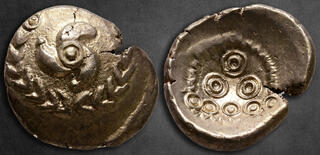 |

